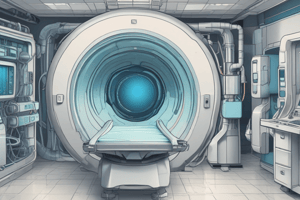Podcast
Questions and Answers
What is the primary limitation of conventional CT scanning as described?
What is the primary limitation of conventional CT scanning as described?
- It requires the X-ray tube to remain stationary.
- It has poor temporal resolution and long procedure times. (correct)
- It uses advanced software for image reconstruction.
- It scans multiple slices simultaneously.
How does helical CT improve upon the limitations of conventional CT?
How does helical CT improve upon the limitations of conventional CT?
- By focusing exclusively on 2D image acquisition techniques.
- By using a single rotation of the X-ray tube to scan all slices.
- By allowing the X-ray tube and detector to rotate continuously while moving the patient. (correct)
- By scanning larger volumes while the patient is stationary.
In a helical CT scan, what does the term 'duty cycle' refer to?
In a helical CT scan, what does the term 'duty cycle' refer to?
- The overall duration of the scanning procedure.
- The percentage of time the X-ray tube is inactive during a scan.
- The length of time spent on patient preparation.
- The ratio of active data acquisition time to total scanning time. (correct)
What advancement does helical CT offer in terms of imaging technique?
What advancement does helical CT offer in terms of imaging technique?
What mechanical process is utilized in conventional CT scanners that contributes to longer scan times?
What mechanical process is utilized in conventional CT scanners that contributes to longer scan times?
Flashcards
Helical CT
Helical CT
A technique in CT scanning where the X-ray tube and detectors rotate continuously while the patient moves through the gantry, acquiring data in a helical or spiral path.
Temporal Resolution
Temporal Resolution
The time it takes to acquire data in a CT scan. A shorter scan time allows for faster imaging and better visualization of moving structures.
Volume Coverage
Volume Coverage
The amount of tissue that can be scanned in a single breath hold. It is improved in helical CT due to continuous data acquisition.
Duty Cycle
Duty Cycle
Signup and view all the flashcards
Single Breath Hold
Single Breath Hold
Signup and view all the flashcards
Study Notes
Conventional CT Scanners (3rd and 4th Generation)
- Patient scanned one slice at a time.
- X-ray tube and detectors rotate 360 degrees or less to scan one slice.
- Table and patient stay stationary during the scan.
- Requires multiple rotations (scanning-braking-reversal).
- Data acquisition time is only 1-2 seconds out of 8-10 seconds per scan.
- Low temporal resolution and lengthy procedure time.
Helical CT Scanners
- Scans a volume of tissue by moving the patient continuously through the gantry while the X-ray tube and detectors rotate continuously.
- X-ray beam traces a path around the patient.
- X-ray tube and detectors rotate continuously, while the patient’s table moves through the rotating gantry.
- Achieves a spiral or helical movement relative to the patient (approximately one revolution per second).
- Continuous data acquisition throughout the scan.
- High duty cycle (nearly 100%) due to continuous data acquisition.
- Improves volume coverage speed.
- Enables fast and continuous data acquisition of a complete volume.
- Allows true 3D image acquisition within a single breath-hold.
Studying That Suits You
Use AI to generate personalized quizzes and flashcards to suit your learning preferences.




